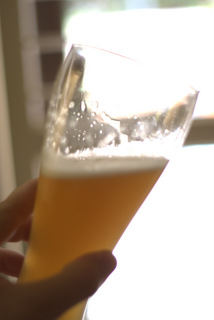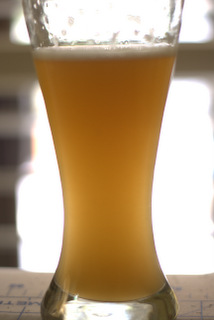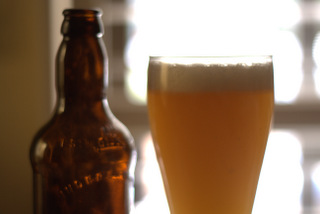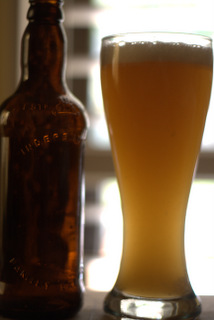harrymanback92
Well-Known Member
Just got done bottling this beer and it will be carbonated in about 4 weeks. The samples I've pulled are delicious. I can already tell all of the flavors I wanted are there. I will post pictures and detailed tasting notes in about 4 weeks.
About this beer: I went to Germany earlier this year and was blown away by how delicious a fresh, properly served Hefeweizen could be. I'm on the West Coast so at the time I was use to only drinking hop bombs and double IPA's. Sipping a refreshing, quenching, sweet, spicy, clove-y, creamy beer changed my perception on what a wheat beer should be. I came home and started trying more and more wheat beers, only to find that a lot of the American Hefeweizen's I was drink were nothing like an authentic Hefe. I did my research and refused to brew a Hefe until I could use all German ingredients, and make the most authentic Hefe that I could. I have to say, at least from the samples, I certainly succeeded at that.
Malts:
7lbs Wheat Malt
3.5lbs German Pilsner Malt
.15 Carapils
.15 Crystal 15
1lb Rice Hulls(for sparge)
Hops:
Hallertau Mittlefruh 3.2%AA
German Magnum 14.1%AA
Mash schedule:
1.5qt water to 1lb grain.
Struck grains at 110F, and slowly brought to 122F over about 15min. Rested at 122F for 20min. Raised to 149F, mashed for 30min. Raised to 156F for 30min. Mashed out at 169F. Vorlaufed for 20min, added in the FWH's(.15oz Magnum, .2oz Hallertau). Sparged with 171F for 45min. Collected all the liquid and brought to a boil.
Hop Schedule:
Boiled for 70min. Added .3oz Hallertau at 60min. Added .3oz Hallertau 30min. 1 pin sized drop of olive oil once wort is cooled. Dry hopped with .15oz Hallertau for 8days.
Yeast:
Made a 1qt starter of WLP300 and wheat dme, w/yeast nutrients(OG of 1.031). Pitched entire starter, liquid and yeast, at 52F. I don't have the best temperature control, but living in the San Francisco Bay Area, our ambient temp is usually around 72-55F. I cooled down my fermenting room at night, down to 55F, and the temp would raise to about 62-64F during the day. I kept it at this temperature range for the entire 10 days it took to ferment.
Bottling:
Add two cups of water, and 1.3 cups of Wheat DME(this may not be necessary to all, but my hefe finished out at 1.010, I was hoping for 1.012-1.014 so I wanted to just add a little bit of body to the beer, hence the DME. Also, I think DME is superior for carbing light beers, but that's purely my opinion-if sugar works for you, do it. If you add sugar though, you would technically be breaking the German Purity Laws. I'm shooting for a carb level of 3 volumbes. A traditionl Hefe should be higher around 3.6, I just don't trust my standard American bottles to hold up to pressure higher than 3 volumes.) I added in a vial of WLP380-Hefeweizen IV yeast. To my surprise, the WLP300 flocculated out more than I was hoping for. I also wanted to intensify the clove-yness, and attempt to get a slight note of apricot.
I know the carapils/crystal15 don't usually get used in a hefe but I had a small amount leftover from another batch and the two were mixed together so I added it. I think crystal15 gives a nice sweetness to beers, but you could probably do without and it would be fine.
The next time I make this I will be adding in 1lb of Munich malt, and I'll be doing a decoction mash. I'll post pictures as soon as the beer is carbonated! I'm very excited about this beer. It's, at least from the samples, the best beer I've made so far.
About this beer: I went to Germany earlier this year and was blown away by how delicious a fresh, properly served Hefeweizen could be. I'm on the West Coast so at the time I was use to only drinking hop bombs and double IPA's. Sipping a refreshing, quenching, sweet, spicy, clove-y, creamy beer changed my perception on what a wheat beer should be. I came home and started trying more and more wheat beers, only to find that a lot of the American Hefeweizen's I was drink were nothing like an authentic Hefe. I did my research and refused to brew a Hefe until I could use all German ingredients, and make the most authentic Hefe that I could. I have to say, at least from the samples, I certainly succeeded at that.
Malts:
7lbs Wheat Malt
3.5lbs German Pilsner Malt
.15 Carapils
.15 Crystal 15
1lb Rice Hulls(for sparge)
Hops:
Hallertau Mittlefruh 3.2%AA
German Magnum 14.1%AA
Mash schedule:
1.5qt water to 1lb grain.
Struck grains at 110F, and slowly brought to 122F over about 15min. Rested at 122F for 20min. Raised to 149F, mashed for 30min. Raised to 156F for 30min. Mashed out at 169F. Vorlaufed for 20min, added in the FWH's(.15oz Magnum, .2oz Hallertau). Sparged with 171F for 45min. Collected all the liquid and brought to a boil.
Hop Schedule:
Boiled for 70min. Added .3oz Hallertau at 60min. Added .3oz Hallertau 30min. 1 pin sized drop of olive oil once wort is cooled. Dry hopped with .15oz Hallertau for 8days.
Yeast:
Made a 1qt starter of WLP300 and wheat dme, w/yeast nutrients(OG of 1.031). Pitched entire starter, liquid and yeast, at 52F. I don't have the best temperature control, but living in the San Francisco Bay Area, our ambient temp is usually around 72-55F. I cooled down my fermenting room at night, down to 55F, and the temp would raise to about 62-64F during the day. I kept it at this temperature range for the entire 10 days it took to ferment.
Bottling:
Add two cups of water, and 1.3 cups of Wheat DME(this may not be necessary to all, but my hefe finished out at 1.010, I was hoping for 1.012-1.014 so I wanted to just add a little bit of body to the beer, hence the DME. Also, I think DME is superior for carbing light beers, but that's purely my opinion-if sugar works for you, do it. If you add sugar though, you would technically be breaking the German Purity Laws. I'm shooting for a carb level of 3 volumbes. A traditionl Hefe should be higher around 3.6, I just don't trust my standard American bottles to hold up to pressure higher than 3 volumes.) I added in a vial of WLP380-Hefeweizen IV yeast. To my surprise, the WLP300 flocculated out more than I was hoping for. I also wanted to intensify the clove-yness, and attempt to get a slight note of apricot.
I know the carapils/crystal15 don't usually get used in a hefe but I had a small amount leftover from another batch and the two were mixed together so I added it. I think crystal15 gives a nice sweetness to beers, but you could probably do without and it would be fine.
The next time I make this I will be adding in 1lb of Munich malt, and I'll be doing a decoction mash. I'll post pictures as soon as the beer is carbonated! I'm very excited about this beer. It's, at least from the samples, the best beer I've made so far.







